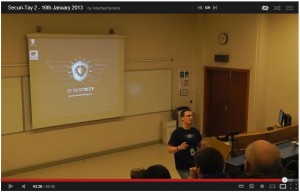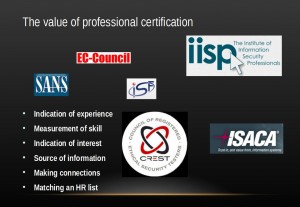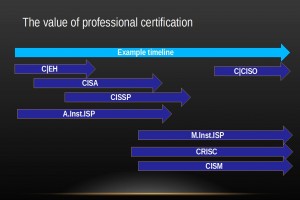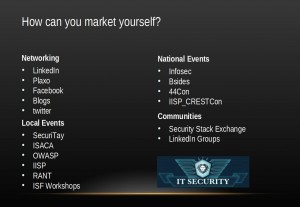Archive for March, 2013
Presentations: Starting your security career – where can you go?
I gave a talk on career planning in Information Security at Abertay University on the 16th of January 2013.
Securi-Tay is an annual security conference organised by students at Abertay and is a very well organised and run event – could put some professional conferences to shame!

The talk went down very well, with a lot of discussion spinning off afterwards, and the odd additional visitor to Sec.SE
Most of the video should be straightforward, but a couple of the slides may be hard to read so I have included them here:
Slide 8, industry trends:
Slide 13, some useful certifications:
QoTW #44: How to block or detect user setting up their own personal wifi AP in our LAN?
Nominated by Terry Chia, this question by User15580 should be of interest to anyone managing the security of network s.
The show the variety of aspects security covers in this sort of scenario:
Daniel posted the top answer, and it has nothing to do with IT, but instead focuses on the cause – if a user has installed an access point it is because they need something the existing network is not providing. This is always worth considering:
Discuss with the users what they are trying to accomplish. Perhaps create an official wifi network ( use all the security methods you wish – it will be ‘yours’ ). Or, better, two – Guest and Corporate WAPs.
Polynomial and Thomas Pornin also highlighted the fact this is a user/managerial problem, rather than a technical one.
Remember Immutable Law of Security #10: Technology is not a panacea. Whilst technology can do some amazing things, it can’t enforce user behaviour. You have a user that is bringing undue risk to the organisation, and that risk needs to be dealt with. The solution to your problem is _policy_, not technology. Set up a security policy that details explicitly disallowed behaviours, and have your users sign it. If they violate that policy, you can go to your superiors with evidence of the violation and a penalty can be enforced. As long as the users have physical access to the machines they use and their USB ports (that’s hard to avoid, unless you pour glue in all the USB ports…) and that the installed operating systems allow it (then again, hard to avoid if users are “administrators” on their systems, in particular in BYOD contexts), then the users can setup custom access points which gives access to, at least, their machine.
Rory McCune provided some information on the types of solutions which generally are used in large corporates, where they work well, including NAC and port lockdowns. Lie Ryan‘s comments tend to be appropriate on smaller networks.
k1DBLITZ also focuses on the use of technical solutions in addition to policy, and JasperWallace recommends looking for and blocking unapproved MAC addresses, and further answers discuss wireless scanning and scripted checks.
Overall, it would seem that a mixture of technical and management controls are required – the balance depending on your specific environment.
Liked this question of the week? Interested in reading it or adding an answer? See the question in full. Have questions of a security nature of your own? Security expert and want to help others? Come and join us at security.stackexchange.com.
QoTW #43: Teaching a loved one about secure coding practices
Today’s blog post is on a question posted on Security Stackexchange last year title Teaching a loved one about secure coding practices.
Ignoring the obvious innuendos in the comments, I think this is an excellent question. While the question is far longer, this is the gist of it.
As ITSec pros, we talk about infusing the development cycle with secure coding practices and design, but how does that apply to a brand-new learner? A new programmer is at the start of their own ‘lifelong development cycle’, at it were. At what point is it appropriate, from an educational perspective, to switch from the mindset of ‘getting it to work’ to ‘it absolutely must be secure’? At what point should a student ‘fail’ an assignment because of a security issue?
As a student in an infosec diploma course, I have rather strong opinions on this matter. Let’s start with a personal anecdote. I personally started learning programming on my own due to self-interest. My first exposure to “real” programming is through PHP(I know… shudders). Do a quick google search using the terms “php tutorial”. Go on. The very first link points towards w3schools.com.
A quick browse through the site looks good. Nice, simple, easy to follow tutorials on the basics of PHP and HTML. Wait, are they really teaching unparameterized queries? In 2013? Really? I’d like to point you to this website. In particular, this quote.
W3Schools.com is not affiliated with the W3C in any way. Members of the W3C have asked W3Schools to explicitly disavow any connection in the past, and they have refused to do so. W3Schools frequently publishes inaccurate or misleading content. We have collected several examples illustrating this problem below.
This is an obvious problem. A website on the top of Google’s search results targeted at new programmers providing misleading information? What could go wrong right?
Moving on to the actual question.
User Everett stated this in his answer.
The problem I see, is that secure programming is taught as an add on. Best practices should be taught from the beginning (including security). The lie people are taught is that practice makes perfect. The truth is practice makes permanent. So if you are doing it wrong, you have to unlearn what you have learned. That is a bassackwards approach. I would say that secure coding practices should be taught from day one. There’s no reason to learn how to do it, and then learn how to do it securely. It’s a waste of time and money…
I disagree with his opinion. I think user KeithS provides a very good point.
It’s great to say “Secure coding practices should be taught from day one”, and very hard to demonstrate how that day-one “Hello World” program may be vulnerable, especially when “what is a computer program” is a new concept for the class.
I agree. Many of my peers who entered the diploma course without any prior programming experiences have a tough time even wrapping their heads around basic concepts like looping and conditional statements. Introducing more complex security topics at this point in their education would more likely cause more harm than good.
This is the answer I provided to the question.
I would say a great way to learn is for her to break the applications she has already written. Assuming she is writing web applications, point her towards the OWASP Top 10. Have her see if she can find any of those flaws in her own code. There is no better way to learn about security concepts than actually seeing it happen on your own code. Once a flaw has been found, have her rewrite the application to fix the flaw. Doing so will allow her to appreciate the effect of things like sanitation and validation of user inputs and parameterized queries. Take incremental steps. I wouldn’t jump straight into designing a new application with security in mind before truly understanding what type of codes result in security flaws.
With 37 upvotes and the answer being accepted, it is clear that the community agrees with me.
Conclusion
I think the best approach to teaching secure programming is an iterative one. Start off the students with writing simple applications. Have the students go back and look at their code and see how it can be broken. Refer them to good resources like the OWASP Top 10 list. With a little critical thinking, the students should be able to start figuring out what went wrong in their code and how to fix it.
Like user AviD said,
Students that do not practice critical thinking shouldn’t really be learning programming….
This post is a cross-post from my blog at http://www.infosecstudent.com/2013/02/teaching-secure-programming-how-to-do-it-right/
Liked this question of the week? Interested in reading it or adding an answer? See the question in full. Have questions of a security nature of your own? Security expert and want to help others? Come and join us at security.stackexchange.com.




